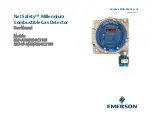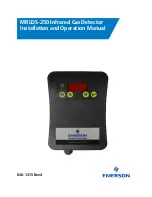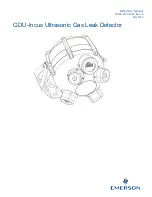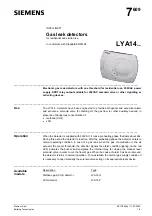
Description
Hydrogen detector-transmitter E2611-H2
is intended for early detection of
leakages or accumulation of hydrogen in confined spaces.
The instrument is based on fully calibrated and temperature compensated
semiconductor metal-oxide (MOS) gas sensor with high repeatability,
stability and long lifetime. The sensor exhibits high sensitivity and selectivity
to methane. Pellistor (catalytic bead) sensor is available as an option.
E2611 provides two independent analog outputs OUT1 and OUT2, user-
selectable to 4-20 mA or 0-10 V, proportional either to gas concentration or
temperature. RS485 Modbus RTU digital communication interface allows
easy instrument configuration and integration into various automation
systems. Two relays RE1 and RE2 with closing contacts can be used to
switch 24 V or 230 V powered alarm sirens, ventilation fans, shut-off valves
or other actuators.
Safety requirements
Always adhere to the safety provisions applicable in the country of use. Do
not perform any maintenance operation with the power on. Do not let water
or foreign objects inside the device.
Operating conditions
•
The device should be used in explosion-safe (non ATEX -rated) indoor
areas at the atmospheric pressure ±10%, <95 %RH, without condensation,
and temperature within the range -30...+70 °C for MOS-type devices /
-20...+60 °C for pellistor type.
•
Metal-oxide and pellistor sensors cannot properly operate in a zero or low
oxygen content atmosphere. Normal ambient oxygen concentration is
recommended.
•
Avoid exposure to highly corrosive gases (H
2
S, SO
2
, HCl, Cl
2
etc), and
volatile silicon containing materials.
•
Avoid mechanical shock or strong vibrations.
•
Avoid sources of electromagnetic interference
Installation and connections
The gas detector should be mounted on a wall at a place located not more
than 5 m from possible gas leakage source and not very close to ventilation
openings, with the sensor pointing downwards. As hydrogen is much lighter
than air, it is advisable to place the device near the ceiling. The device
should be available for maintenance and repair.
1. Detach the base of the enclosure by gently pulling along four guiding
pins.
2. Fix the base on the wall with two screws. (see drawing below).
85
37
8
5
63
3. Connect power supply and external devices to the terminal blocks on the
PCB according to the connection diagram below.
To power the instrument from an external 24 VDC source, connect terminals
0 V and +U to the source. If an integrated mains power supply module is
used, connect terminals L and N to the mains.
To use analog outputs, connect the terminals OUT1 and/or OUT2 and 0 V
to the input of the secondary instrument (indicator or controller).
NB!
The outputs are not galvanically isolated from 24 V power supply and
share common 0 V. Allowed load resistance limits are stated in
Specifications table.
The type of each analog output can be independently selected with the
appropriate jumper (J1 for OUT1 and J2 for OUT2). With jumper open, the
output type is 4-20 mA. With jumper closed, the output type is 0-10 V.
To use relay outputs, connect the chosen actuators to the relay terminals
RE1 and/or RE2.
NB!
Actuator short-circuits shall be avoided, to protect the instrument relays
use external fuses or safety switches.
4. Turn on the power. It may take up to five minutes after switching on for
the sensor to stabilize. During this period relays, analog outputs and
Modbus interface are off. A LED placed on the PCB of the device allows to
control the connection process. The LED response to different processes is
presented in the table below.
Process
LED mode
Sensor heating period
Blinking 0.5 Hz (50% on, 50% off)
Sensor absence or malfunction
Blinking 0.5Hz (90% off, 10% on)
Relay 1 turned on
Blinking 1 Hz (50% on, 50% off)
Relay 2 turned on
Blinking 2 Hz (50% on, 50% off)
Modbus response
The signal is modulated with short onoff
pulses, even single Modbus cycle is traceable*
Normal measurement
Continuous light
5. Push enclosure to the base.
Operation
For best stability the gas detector should be powered permanently. If the
instrument is left for a long time in unpowered state, then after initial power-
on the metal-oxide gas sensor needs some time to heat up and burn
adsorbed contaminants. So for first tens of seconds of few minutes an
alarm activation may be possible. After this heating-up period the
instrument turns into normal mode.
When the concentration of the detected gas reaches the LOW alarm level,
the control LED starts blinking and the buzzer starts beeping with 1 Hz
frequency. When the HI alarm level is reached, the frequency of
blinking/beeping is 2 Hz. The alarm signal turns off automatically, if gas
concentration decreases to 80% of the alarm setpoint.
Configuring
Gas detector E2611 shares all functionalities of the PluraSens®
multifunctional transmitter platform. The features and options include:
- digital output change rate limiting filter
- digital integrating (averaging) filter
- temperature measurement channel with internal sensor
- free assignment of each analog output to chosen parameter
- flexible setting of analog output scales for each output
- output shift and slope adjustment for calibration
- free assignment of each of two relays to chosen parameter
- several relay control logic modes (HI or LO with hysteresis, U or П)
- switch delays and minimum on/off state durations for each relay
- Modbus controlled forced state option for analog outputs and relays.
E2611 can be configured through its RS485 interface by Modbus RTU
commands. A standard configuration kit includes Model E1087 USB-RS485
converter and E26XX Configurator software. Please contact your Seller or
the Manufacturer for more information.
Return to default settings
To reset the device’s Slave ID, baudrate and sbit number to factory settings,
proceed as follows:
1. De-energize the device
2. Connect the J3 jumper
3. Turn on the device
4. De-energize the device
5. Disconnect the J3 jumper
6. Turn on the device
Calibration
E2611-H2 has been calibrated by Manufacturer with standard gas mixtures
before delivery. The semiconductor gas sensor exhibits high stability and >
5 years lifetime. However, as the gas sensor is directly exposed to
environment, the instrument requires at least annual field recalibration with
a portable calibration kit. The catalytic sensor is more sensitive to the
environment and requires calibration every 3...6 months.
The calibration should be performed by qualified specialist. Please contact
your dealer for more information.
Warranty
This product is warranted to be free from defects in material and
workmanship for a period of one year from the date of original sale. During
this warranty period Manufacturer will, at its option, either repair or replace
product that proves to be defective. This warranty is void if the product has
been operated in conditions outside ranges specified by Manufacturer or
damaged by customer error or negligence or if there has been an
unauthorized modification.
Delivery set
– Methane detector-transmitter E2611-H2
– Mounting accessories: 2 screws and 2 plastic dowel plugs
Input 1 4-20 mA / 0-10 V
Input 2 4-20 mA / 0-10 V
0V / GND
Controller
OUT1
OUT2
0V
A
B
RS485
+U = 11...30 VDC
L
N
90...265 VAC
RE1
RE2
Fieldbus
S
PSU
24 VDC
+
-
J1 J2
230 VAC
J3
Control LED




















